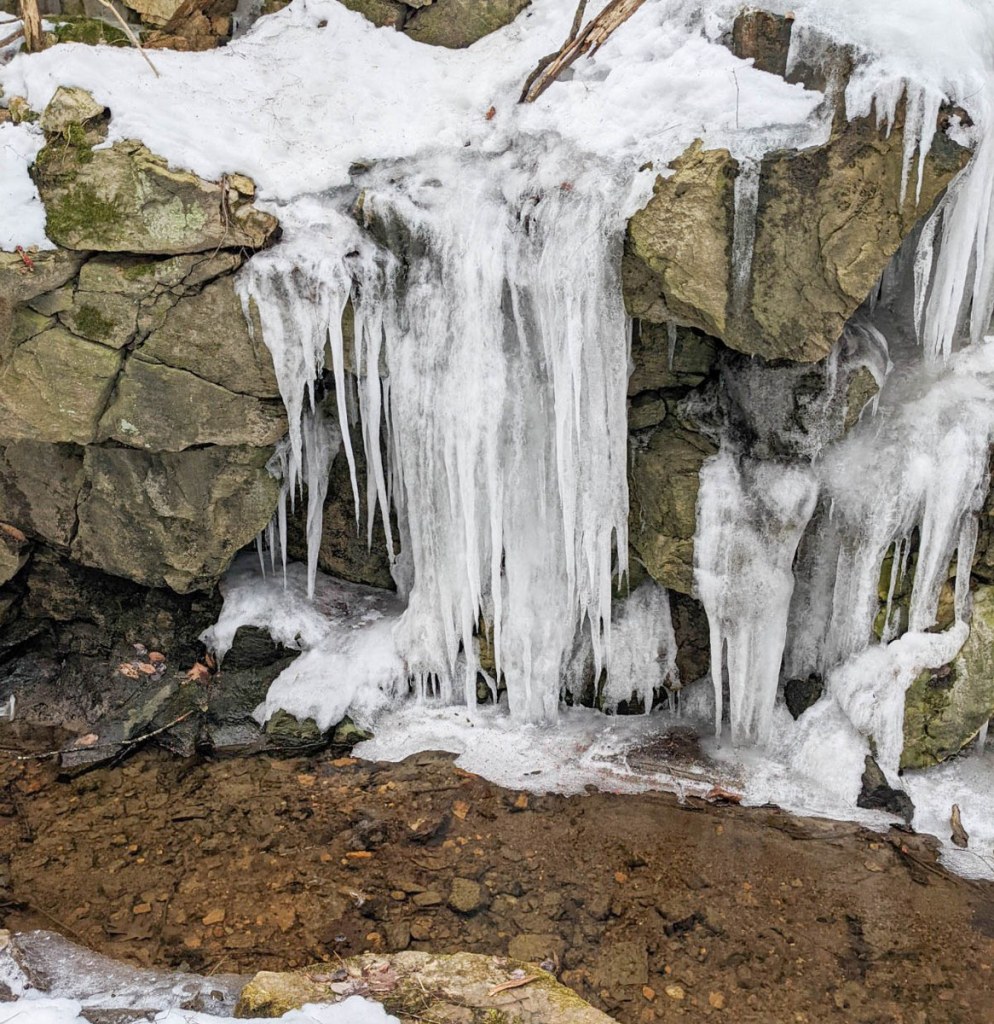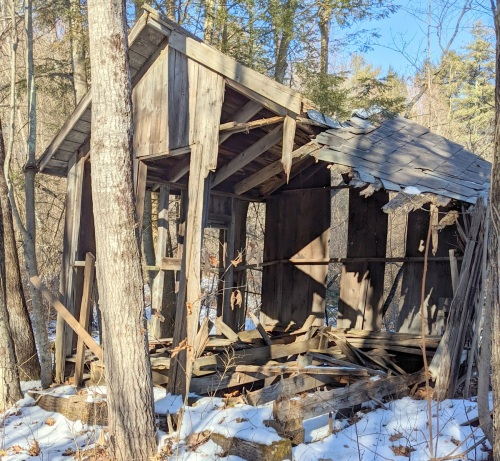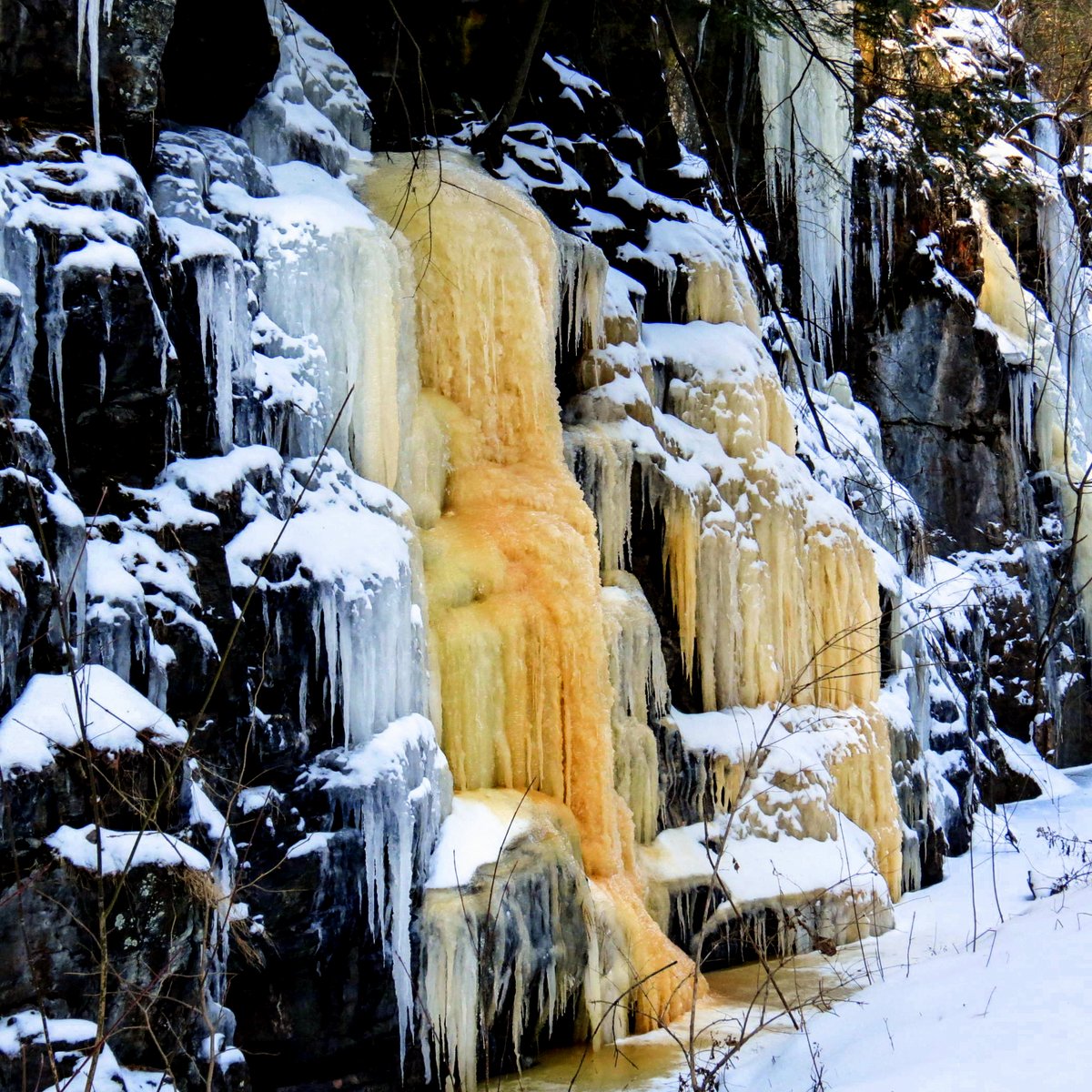
Last Thursday I went up to the deep cut rail trail in Westmoreland to see if there was any ice in the man-made canyons. I really didn’t expect to see much because we’ve had such a mild winter but there it was. I’ve seen this place in February when there was so much ice you could hardly see any stone, and other times when there was hardly any ice at all. The temperature this morning on the outside was about 37 degrees but down here it’s usually about ten degrees cooler. Once the ice grows the place almost makes its own weather and it stays cold until the air temperature on the outside reaches into the 50s. That’s why ice climbers call it the ice box.

On the shaded side the ice is good and solid and climbable but the side that sees sunshine can melt quicky on warm days.

Without people the scale of the place in photos is deceiving, so here are some ice climbers from a few years ago. That year saw a real lack of ice. Many of the people who climb here are trainees from the New Hampshire Branch of the Appalachian Mountain Club. Unless they’re standing around and not climbing I rarely speak to these people because I don’t want to break their concentration. They are “in the zone” and I’d like them to stay there, so I take a couple of quick long shots and leave.

I don’t believe they ever climb the colored ice. This ice grows like this in this same spot each year and I’ve never seen any signs that it has been climbed. There are usually a lot of footprints at the base of ice that has been climbed.

What colors the ice is I believe, mineral laden ground water. This water seeps from cracks in the stone year-round and in places like the one in the photo, it pours off the walls in small waterfalls. The sound of falling, splashing, tinkling water can be heard here always.

This deepest canyon with climbable ice is to the north but there is also a southern canyon, and this view looks out of the northern canyon in that direction.

This stretch of railroad once ran from Bellows Falls, Vermont to various towns in northern Massachusetts after being built in the mid-1800s. When the route runs through, rather than over or around a hill it is known as a deep cut. This photo shows what the deep cut looked like circa 1870 when it was relatively new. If I had to guess I’d say the man on the right was either picking berries or clearing the drainage channel. You can see a pile of unused rails there in the lower right. Did they bend the rails around curves as they laid them or did they come with the required radius already in them, I wonder. The Cheshire Railroad was swallowed up by the Fitchburg (Massachusetts) Railroad, which in turn was bought out by the Boston and Maine Railroad. This photo is from the Cheshire County Historical Society. I believe it looks toward the southern end of the northern canyon, just as the previous shot does, but from further back in the canyon.

A stainless steel 3 car diesel streamliner with “Cheshire” (for the Cheshire Railroad) proudly displayed on its nose ran through here from 1935 until it was retired in 1957. According to the description a big 600 horsepower Winton engine was in the first car. The second car was a combination baggage / mail / buffet dining car, and the third car had coach seating for 188 passengers with rounded glass on its end that allowed 270 degrees of countryside observation. Though I’ve written the historical description here you’ll note that there is actually and engine and three cars on this train, not an engine and two cars. A sister train called The Flying Yankee ran on another part of the railway.

There is a lot of stone left over when you blast your way through a hillside and this is how some of it was used. For someone who has built stone walls, this huge retaining wall is a thing of beauty as well as quite an engineering marvel. It leans back into the hillside at about ten degrees to keep the hillside from falling or washing onto the railbed, and it has worked just as it was designed to for 150 years or more. Not a stone has moved, and there isn’t a single teaspoon of mortar in it. These men were true craftsman, most likely from Scotland from what I’ve read. They built some beautiful things off in the middle of nowhere where nobody would see them because they took great pride in their work.

Though the southern canyon seen here gets more sun because of its shorter 20–30-foot walls, there is usually more ice on this end. These walls are always wet in summer but you don’t realize what that means until you come here in the winter. There are huge amounts of groundwater flowing through the earth in this spot and it can turn into ice columns as big as tree trunks. Though it looks like a lot of ice in this shot there might be less than half what there is in an average year.

And it was starting to fall. When these tree trunks made of ice start to pull away from the walls and fall, some of them can fall all the way across the trail, so it’s a good idea not to be here when it happens. I saw evidence of falling ice here on this day in various spots and any one of the larger pieces in this photo could kill a person. It’s a dangerous situation so when this starts, I stay away. On this day I heard the tinkling sounds of small icicles falling all along the trail so I stayed in the middle and kept moving.

You have to look carefully to see what is happening in this photo but the darker color in the center is stone showing through the ice. Sun shines through the ice and warms the stone and in this case about 4 inches of ice that once grew against the stone has melted away, leaving a gap between the ice and stone. What this means is that the stone is no longer supporting the ice, so some of these masses of ice have become self-supporting. Since we have temperatures in the mid-40s F. as far out as the forecast goes, that’s not good for the ice or anyone using the trail. Being in the wrong place at the wrong time wouldn’t be good.

Blue ice is the densest and most solid, but once its grip on the stone melts away even it will fall. The top of the mass on the left doesn’t appear to be attached firmly to the stone.

In contrast to the shiny, dense blue ice in the previous photo the ice seen here is rotten, meaning water, air bubbles, and/or dirt have gotten in between the grains of ice and cause it to honeycomb and lose its strength. Instead of a sharp ringing crack when it is struck it produces more of a dull thud. The ghostly grayish white color and matte finish are a sure sign that you should stay away from it when it’s hanging over your head.

Here is another example of rotten ice. It just doesn’t look like what you would expect from good, healthy ice. Beware of ghostly fingers of ice, maybe?

This is good, healthy ice of the kind that will make a ringing, almost cracking sound when it is struck. Shiny, clear, and dense, it won’t fall right away. The ice that grows in this spot always imprisons the fern seen behind it, year after year since I’ve been coming here.

For years this orange patch, caused by the green algae called Trentepohlia aurea, has been on one wall of the southern canyon but its spores must have crossed the gap because now it is on both walls. Though it is called green algae a carotenoid pigment in the alga cells called hematochrome or beta- carotene, which is the same pigment that gives carrots their orange color, hides the green chlorophyll.
You can also see the straight, vertical pocket in the stone left by a steam drill there in the upper right in this photo. You drilled the hole, filled it with black powder, lit the fuse, and ran as fast as you could go. Of course, they would have been on what is now the rim of the canyon, so they could just run off into the woods and hide behind trees. That’s what I would have done anyway.

I hoped I’d see some lacy ice patterns on the drainage channels but instead I saw either reflections in them or white sheets of ice covering them.

This formation looked like icicles had formed and then had an ice column form around them. I’ve never seen this happen before.

And this is something I hoped I wouldn’t see. We had rain that froze into a coating of ice and then several inches of wet snow fell on top of it, and I wondered about the lineman’s shack when I was trying to shovel it in my yard. It tore limbs from trees and knocked other trees down completely and thousands lost power. Here all it did was flatten an old shack that few cared anything about. I cared about it because I saw it as an irreplaceable part of the history of the place, but short of somehow getting a team of carpenters out here there was little I could do to save it.

The more expensive slate on the roof shows how much the builders thought of the place, and the hole through the peak of the roof for a stovepipe answered a question I’ve had for a long time, and that was, did people stay in this building for some length of time waiting for something to take place. They must have, otherwise a stove wouldn’t have been needed. If you think about the possibility of all that ice, some two or three times taller than a train in places and as big around as a tree, falling when a train went through it becomes plausible that someone would have had to remove it somehow, though I couldn’t guess how. It might have been as simple as shooting at it to break it up and then wheeling the bigger pieces down the track in a hand cart to be dumped outside the canyon. If that were true the ice would have had to have been removed through January and February if the weather then was anything like it is now.

Here is the place as I first found it years ago. Not much, but much more than it is now. The stove would have been what looks like about 5 feet out from the back wall.

For years I thought juveniles had gotten into the building and written their initials on the back wall but I know now that what is seen here would have been almost behind where the stove was, so I’d guess that the people who once used this building probably did it. They might have had a lot of time on their hands, sitting and warming up before the next cold job in the canyons.
The best thing about the cold was the comfort that came from escaping it. ~ Claire Lombardo
Thanks for stopping in.



































































































































































































